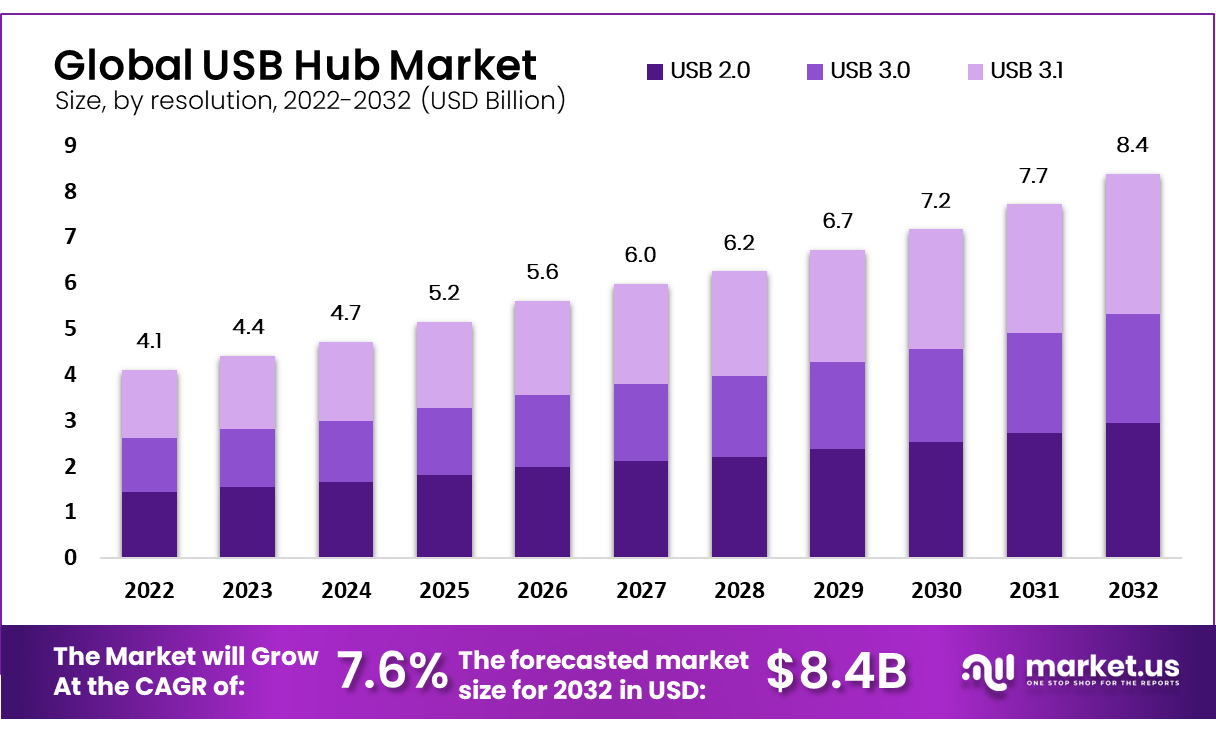USB Hub Market Share to Hit USD 8.4 Billion, Globally, by 2032 with 7+% CAGR

Market Overview
Published Via 11Press : The USB hub market has witnessed significant growth in recent years due to the increasing demand for additional USB ports. A USB hub is a device that allows multiple USB peripherals to be connected to a single computer port. This enables users to connect multiple devices such as keyboards, mice, printers, and external hard drives simultaneously.
USB Hub Market size is predicted to grow to approximately USD 8.4 Billion before 2032. This is up starting at USD 4.1 Billion by 2022. This is projected to increase by a rate of 7.60% during the forecast timeframe from 2023 until 2032.
One of the key drivers of the USB hub market is the proliferation of smart devices and their connectivity requirements. With the rise in popularity of smartphones, tablets, and other portable devices, there is a growing need for more accessible charging and data transfer options. USB hubs offer an efficient solution by expanding the number of available ports on these devices.
The USB hub market is also benefiting from technological advancements that have improved its functionality and compatibility. For instance, modern USB hubs are equipped with features like fast charging capabilities, data transfer speeds up to 10 Gbps (USB 3.2 Gen 2), and backward compatibility with older versions of USB ports. These advancements have made USB hubs more versatile and appealing to consumers looking for convenient connectivity solutions across various devices.
For insights on global, regional, and country-level parameters with growth opportunities from 2023 to 2033 – Download a FREE sample report @ https://market.us/report/usb-hub-market/request-sample/

Key Takeaway
- The USB Hub Market is projected to reach USD 8.4 Billion by 2032.
- This growth is anticipated at a CAGR of 7.60% during the forecast period up to 2032.
- USB Hubs enhance single USB ports, allowing connection to multiple devices.
- These hubs facilitate data sharing among connected devices.
- The market demand for USB Hubs is increasing in IT sectors, gaming, residential, and other industries.
- USB Hubs benefit from the growth of AI, machine learning, and blockchain technologies.
- The e-sports and gaming sector significantly contributes to USB Hub market growth.
- IoT growth drives the need for USB Hubs supporting a wide range of devices.
- Advanced technologies like high-speed data transfer and wireless charging are boosting USB Hub demand.
- USB Type-C ports are becoming more common, further driving the market.
- The Thunderbolt's popularity poses a restraint to USB Hub market growth.
- Thunderbolt offers lightning-fast data transfer and versatile connectivity.
- USB Type-C technology is gaining popularity in consumer electronics.
- USB Type-C devices support high-speed data transfer rates.
- Demand for USB hubs with multiple ports is increasing.
- USB hubs cater to education, medical devices, and the booming e-sports industry.
- USB Hub devices allow multiple USB connections to a single computer port.
- USB Type-C hubs are versatile connectors for newer devices.
- USB 3.0 dominates the USB Hub market in 2022.
- USB 3.0 offers 4x faster transfer rates than previous versions.
- USB 3.1 is expected to show the highest CAGR.
- USB 3.1 supports data transfer of up to 12 Gbps.
- USB 2.0 offers data transfer speeds up to 480Mb/s.
- Commercial segment holds the largest market share in 2022.
- The rise of digitalization contributes to the commercial sector's USB Hub demand.
- The residential segment is expected to grow due to work-from-home trends.
- The COVID-19 pandemic negatively impacted the USB Hub market worldwide.
- Lockdowns, social distancing, and supply chain disruptions affected the market.
- North America held the largest market share in 2022.
- Silicon Valley is home to major market players.
- The Asia Pacific region is expected to register the highest market share.
- Digital technologies, automation industries, and IoT adoption drive growth in APAC.
- Europe sees rapid growth due to advances in technology and IoT adoption.
- The USB Hub market is fragmented with the presence of local and regional players.
- Market players face intense competition from top brands.
- Anker Innovations Co. Ltd is a prominent USB Hub market player.
- StarTech.com is another key player in the market.
- USBGear.com is a recognized name in the USB Hub industry.
- Vaunix Technology Corp. contributes to the USB Hub market.
- Belkin International, Inc. is a major player in the market.
- Honeywell International is part of the USB Hub market.
- Texas Instruments is a significant player with expertise in energy-efficient power electronics.
- In September 2021, Delta Electronics and Texas Instruments developed an enterprise server power supply unit.
- In June 2021, Sony Semiconductor Solutions Corporation introduced the IMX585, a 4k CMOS image sensor.
USB Hub Facts
- USB Standards and Speeds:
- USB 1.0: Introduced in January 1996, with data transfer rates of 1.5 Mbps (Low Speed) and 12 Mbps (Full Speed).
- USB 2.0: Released in April 2000, significantly improved data transfer rates to 480 Mbps (High Speed).
- USB 3.0: Announced in November 2008, with data rates of up to 5 Gbps (SuperSpeed).
- USB 3.1: Introduced in July 2013, doubled the transfer rate to 10 Gbps (SuperSpeed+).
- USB 3.2: Announced in September 2017, introduced multi-lane operation to double the bandwidth to 20 Gbps (SuperSpeed+ 10 Gbps or SuperSpeed+ 20 Gbps, depending on the configuration).
- USB4: Announced in August 2019, supports 40 Gbps (SuperSpeed) data transfer rates, utilizing Thunderbolt 3 technology.
- Power Delivery (PD) Standards:
- USB Power Delivery 2.0: Can supply up to 100 Watts at 20 Volts, enabling charging of larger devices like laptops.
- USB Power Delivery 3.0: Introduced PPS (Programmable Power Supply) for more efficient power management.
- Number of Ports:
- USB hubs can vary significantly in the number of ports offered, ranging from 2 to 16 ports or more, to accommodate various user needs.
- Form Factors:
- USB hubs come in a variety of form factors, including compact, portable designs for mobile use, and larger, desktop models with additional features like Ethernet ports, SD card slots, and audio jacks.
- Compatibility:
- USB hubs are designed to be backward compatible, meaning a USB 3.0 hub can work with USB 2.0 devices, albeit at lower speeds.
- Adoption Rates:
- The adoption rates of USB technologies have steadily increased with each new standard, reflecting advancements in data transfer speed and power delivery capabilities.
- USB-C:
- The introduction of the USB Type-C connector has further standardized the use of USB, offering reversible plug orientation and the potential for universal charging solutions across a wide range of devices.
Recent Developments
In recent developments of USB hubs in 2023, advancements have focused on enhancing connectivity, speed, and versatility to accommodate the increasing demand for high-performance and multifunctional devices. Notable offerings include:
- Anker's Range of USB-C Hubs: Anker introduced the Anker 555 USB-C Hub (8-in-1) and Anker 543 USB-C Hub (6-in-1, Slim), both providing extensive connectivity options including USB-C Power Delivery input ports, USB-A and USB-C data ports, Ethernet, HDMI, and microSD/SD card readers. The Anker 555 hub supports file transfer speeds of up to 10 Gbps and HDMI resolutions up to 4K@60Hz, while the Anker 543 offers similar capabilities with slightly different port arrangements.
- TP-Link UH-720: A 2nd generation powered USB hub with 7 USB 3.0 ports and 2 charging ports, capable of charging devices at up to 5V/2.4A. It's noted for its efficient power management and port spacing that accommodates larger devices without interference.
- HooToo USB C Hub: Offers a compact solution for modern connectivity needs, featuring USB 3.0 ports, HDMI output supporting UDH 4K, a Type-C charging port, and an Ethernet port. It emphasizes the versatility of USB Type-C technology, allowing simultaneous video, power, and data transmission through a single port, especially for MacBook Pro models.
- AmazonBasics 7 Port USB 3.0 Hub: Provides a straightforward, efficient solution with 7 USB 3.0 ports, emphasizing affordability and portability. It supports backward compatibility with USB 2.0 or 1.1 devices and can switch between bus-power and self-power modes.
- Innovative Designs and Port Options: The landscape of USB hubs in 2023 highlights the importance of design and functionality, with products offering a range of ports including USB 3.0, HDMI, Ethernet, and SD card readers to accommodate various peripheral devices. Some hubs, like the VAVA 12-in-1 USB-C Hub, even include multiple HDMI ports, Ethernet, and USB-C PD ports, showcasing the trend towards hubs that can serve as comprehensive docking stations for both home and office use.
The team behind market.us, marketresearch.biz, market.biz and more. Our purpose is to keep our customers ahead of the game with regard to the markets. They may fluctuate up or down, but we will help you to stay ahead of the curve in these market fluctuations. Our consistent growth and ability to deliver in-depth analyses and market insight has engaged genuine market players. They have faith in us to offer the data and information they require to make balanced and decisive marketing decisions.



